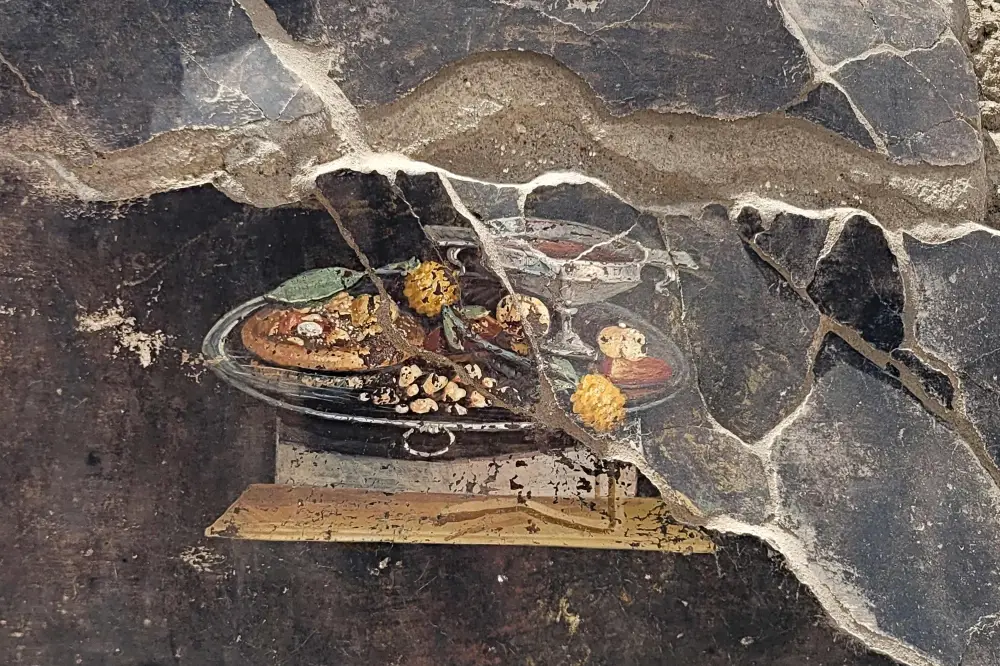 rchaeology has a way of revealing tantalizing glimpses into the past, unearthing artifacts that shed light on the lives and cultures of our ancestors. In a surprising and mouthwatering twist, recent archaeological excavations have unearthed a remarkable find—a pizza painting dating back over 2,000 years. This discovery offers a unique window into the culinary delights and artistic expressions of ancient civilizations. In this article, we delve into the fascinating details of this extraordinary artifact and explore the significance it holds for our understanding of food and art in the ancient world.
rchaeology has a way of revealing tantalizing glimpses into the past, unearthing artifacts that shed light on the lives and cultures of our ancestors. In a surprising and mouthwatering twist, recent archaeological excavations have unearthed a remarkable find—a pizza painting dating back over 2,000 years. This discovery offers a unique window into the culinary delights and artistic expressions of ancient civilizations. In this article, we delve into the fascinating details of this extraordinary artifact and explore the significance it holds for our understanding of food and art in the ancient world.
Uncovering an Ancient Culinary Delight
Pizza, a beloved and iconic dish of modern times, has a rich and storied history. However, the recent archaeological find takes its origins back even further than previously imagined. The discovery of a pizza painting provides tangible evidence of the existence of this delectable dish in ancient times. The painting, meticulously preserved over centuries, offers a vivid depiction of an ancient pizza, complete with various toppings and an unmistakable round shape.
The pizza painting was unearthed during an excavation at a site believed to have been a bustling marketplace in a once-thriving ancient city. The location of the find hints at the popularity and cultural significance of pizza during that era. This discovery challenges previous assumptions about the origins of pizza and provides valuable insights into the culinary habits and preferences of the ancient civilization that created it.
Detailed analysis and examination of the pizza painting reveal fascinating details about the toppings used in ancient pizza. The painting showcases a variety of ingredients, including cheese, herbs, and what appears to be slices of vegetables. This suggests that even in antiquity, pizza was a customizable dish, allowing individuals to personalize their culinary experience.
Artistic Expressions on a Plate
Beyond its gastronomic significance, the pizza painting offers a glimpse into the artistic expressions of the ancient world. It showcases the skill and craftsmanship of ancient artists, who expertly depicted the textures, colors, and arrangement of the ingredients on the pizza. The attention to detail and the use of vibrant pigments highlight the artistic talent and the cultural importance attached to food in ancient societies.

Art has long been a means of expressing cultural values and societal norms. The pizza painting serves as a testament to the prominence of food in the daily lives of ancient people. It suggests that pizza was not merely a meal but also a symbol of social gatherings, celebrations, and community bonds. The careful depiction of the pizza in the painting indicates that it held a special place in the cultural fabric of the ancient civilization.
Furthermore, the pizza painting raises intriguing questions about the role of food in art throughout history. It prompts us to consider how culinary creations have inspired and influenced artistic endeavors, both past and present. The depiction of pizza in ancient art speaks to the universal human connection with food and the enduring fascination with capturing its essence in artistic forms.
Unlocking Cultural Significance
The discovery of the pizza painting opens up new avenues for understanding the cultural significance of food in the ancient world. Pizza, as depicted in the painting, likely played a central role in communal gatherings, celebrations, and religious rituals. Its presence in the archaeological record offers a valuable glimpse into the daily lives and social dynamics of the ancient civilization that enjoyed this culinary delight.
The pizza painting also sheds light on the interconnectedness of cultures and the exchange of culinary traditions. The portrayal of pizza in an ancient city suggests that it was not confined to a single region but had likely spread and gained popularity across different parts of the ancient world. This finding underscores the role of food as a cultural bridge, connecting people through shared culinary experiences.
Moreover, the pizza painting challenges preconceived notions about the sophistication of ancient cuisine. It dispels the idea that ancient diets were solely focused on survival and sustenance. Instead, it showcases the creativity and culinary ingenuity of ancient cooks, who experimented with flavors, textures, and ingredients to create dishes that delighted the senses.
The discovery of an ancient pizza painting is a remarkable find that offers a tantalizing glimpse into the culinary and artistic heritage of our ancestors. This artifact not only expands our understanding of the historical origins of pizza but also reveals the cultural significance of food in the ancient world. It highlights the universal nature of culinary traditions and underscores the enduring fascination with food as a source of joy, community, and artistic inspiration. The pizza painting serves as a delicious reminder that the pleasures of food and art have long been intertwined throughout human history.
Avid Writer with invaluable knowledge of Humanity!
Upcoming historian with over 30 million views online.
“You make your own life.”





